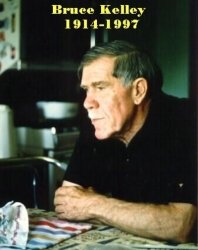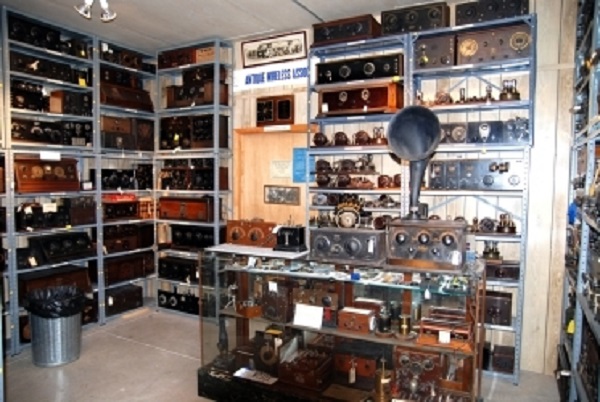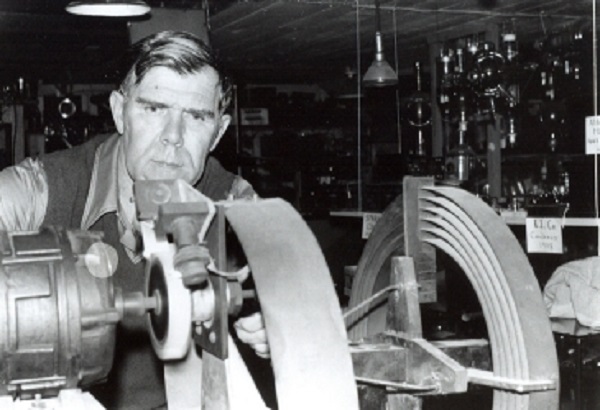|
Bruce L. Kelly Bloomfield, NY QCWA # 1351 |
 |
This story starts in January 1951, with a letter Bruce Kelley wrote to his friend Ed Raser, W2ZI. In it he is telling Ed about a recent meeting of the Rochester Amateur Radio Association where almost 100 turned out at a meeting about early wireless radio. He said, "The overwhelming success of the meeting demands another one this fall." He also asked when Ed was planning his next "Old Timers Nite," in New Jersey, as he would like to attend.
In November 1951 Kelley writes again that he is planning his "Old Timer's Nite" in Early December and asks Ed for some help.
Speaking about his collection Kelley said, "I'm personally interested in collecting old gear but my collection is relatively small compared to yours. I am told that you have one of the largest in the country - if not the largest. I have about 150 tubes of different types prior to 1930 of which 40 are of European origin. Also have a couple Grebe receivers, a Paragon RA-10, an old Navy receiver, odd parts, magazines and catalogs." He also mentioned that he would like to locate some old spark equipment.
In letters dated November 1952 Kelley writes about his "Old Timer's Nite," recently held on October 9, 1952. That 130 hams were present, the majority of whom were active in the 1920s and before. He said that it was very successful and plans to have another one.
The printed OT program was really interesting. Highlights were the illustrated talk on the Transatlantic tests in 1921 called "The Paul Godley Story"; a working 1-KW Spark Rig by George Batterson, W2GB; and a display of 48 early and rare wireless parts and accessories.
Just how did Bruce Kelley take a few old tubes, receivers and some odd parts and turn them into one of the largest radio collections and collector organizations in the United States, and perhaps the world?
I reviewed over 100 letters by Bruce Kelley, written between 1951 and the 1970s. It is very clear that Bruce Kelley was an exceptional man, dedicated to his beloved hobby of ham radio, the ARRL and to his friends. His enthusiasm was infections and he was able to recruit friends and strangers alike to work with him. He was a tireless worker and planner, always gathering information and sharing the same with anyone who would listen. If he heard about someone, another old timer or collector who had radios, he would contact them. If he heard about some old radios forgotten in storage, he would try to get them. If he learned about a long forgotten radio station from the past, he would visit it and take photos to preserve the history. He would make historic slide shows with a tape recorded program, then share them with just about any club that wanted to borrow them. He contacted the ARRL and had them distribute (loan) the slide shows to even more clubs, and they would also be shown at hamfests and conventions. Many times Bruce would accompany the slide shows and bring along some of his collection for show and demonstrations.
Originally Bruce used his barn to store his growing collection. Then he met George Batterson, W2GB, (SK) who still had his early spark transmitter and a lot of old gear stored in his garage. Bruce immediately fell in love with the spark set. George told him, "Why don't you take all this equipment home and let's get a museum started there."
So the AWA got its start with a vision, a gift, and an old barn. By 1954 the membership had grown to 155, mostly local New York amateurs, but 37 were from other states and some were from overseas. The AWA was growing.
In 1958, Bruce moved to Holcomb, New York, into a home which had a fine carriage barn. The AWA museum moved with him. By 1970 the carriage barn was full and overflowing into other local barns. The AWA started to look for larger facilities and found the old Grange Hall in East Bloomfield, New York. A deal was struck with the historical society there and the AWA leased the top two floors. Members went to work and built new displays, including a replica Titanic radio room, complete with correct original Marconi equipment. This building is still in use and you should visit it this summer.
Before long the new museum was full and the AWA built a large building nearby and called it the Museum Annex. This too has become full to overflowing. So the AWA looked around and recently purchased a large building.
The AWA and Amateur Radio:
From the beginning of the organization, amateur radio has played a significant role. All the founders were amateurs, and in the beginning a ham license was a requirement to be an officer. Founders Bruce Kelley, W2ICE, George Batterson, W2GB, and Linc Cundall, W2QY, were active amateurs during the 1930s. Kelley, with an enviable DX operating record during the 1930s, was able to use his association with both the Rochester Amateur Radio Association (where he was a founding member) and the American Radio Relay League to significant advantage in promoting the AWA.
Ed Gable, K2MP, said, "Amateur Radio was the common meeting ground for those wishing to enter the historic radio field to become introduced to those who were already there. It was the foot in the door. How many of these pioneering AWA supporters do you recognize? Thorn Mayes W6AX, George Grammer W1DF, Ed Reddington W4ZM, Bill Halligan W9AC, Ed Raser W2ZI, Bob Merriam W1NTE, Jack Gray W8JDV, Joe Pavek WØOEP, Rex Matlack W3CFC, R.H.G. Mathews 9ZN, Bud Hall K2LP, Bob Morris W2LV, Ken Conrad W2IIE, Louise Moreau W3WRE, Howard Pyle W7OE, Fred Hammond VE3HC, and Bill Orr W6SAI. There are many others."
"The ability to communicate with each other via their own ham sets tied many of these early wireless and radio historians together in this unique way. AWA nets on 75 and 20 meters were widely used in the earlier days."
Kelley mentioned in his letters that he wanted to start a four-page collecting newsletter once a month. This quickly changed into a quarterly one of several pages. True to his nature, Kelley recruited friends to edit various sections so that all he had to do was assemble the various pieces into what was to become, the Old Timer's Bulletin, loaded with wireless history articles. Thus the Antique Wireless Association was born. It started with a few hams that appreciated old radios. Word spread and it has grown into a very active organization of thousands of members from around the world.
The AWA Annual Conferences begin:
In 1963 the summer issue of the Old Timer's Bulletin announces the "First National Get Together" to be held on Saturday, August 17, 1963 in Holcomb, NY. The 1964 summer issue brought an announcement of the second National Meet, to be held on October 3RD at the New England Wireless Museum in East Greenwich, RI. Bob and Nancy Merriam are the hosts.
This yearly gathering of collectors has become "the event" to attend. It typically runs several days and has the following activities: a flea market, an auction, seminars, membership meeting, visits to the AWA Museum, a very prestigious old equipment contest, and a nice awards banquet after. There is too much to do to try and only attend for one day, like a hamfest. Bruce became a SK in 1997.
And it continues today. The AWA is 60 years old this year (2012) and has amassed one of the worlds largest radio collections. Most were donations, and are from members who wanted to share their collections with future generations. What began six decades ago will evolve into the world's premier and most important radio and electronic communications history museum, opening summer 2013. The new AWA Museum and Research Campus will be located in Bloomfield, NY, just two miles east of the present AWA Museum on Routes 5 & 20, in Upstate New York.

